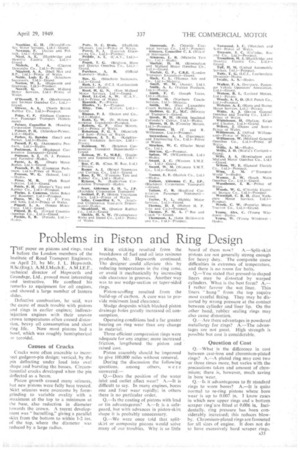Problems in Piston and Ring Design
Page 23

If you've noticed an error in this article please click here to report it so we can fix it.
THEpaper on pistons and rings, read before the London members of the institute of Road Transport Engineers, on April 21, by Mr. J. L. Hepworth,
R.Sc.(Eng.), A.M.I.E,E., technical director of Hepworth and Orandage, Ltd., proved most interesting and instructive. He confined his remarks to equipment for oil -engines, and showed a large number of lantern slides.
Defective combustion, he said, was the cause of much trouble with pistons and rings in earlier engines; indirectinjection engines with their uneven crown temperatures often caused distortion, heavy oil consumption and short ring life. Now most pistons had a howl, which was roughly hemispherical or toroidal.
Causes of Cracks
Cracks were often traceable to incorrect gudgeon-pin design; vertical, by the pin deflecting under load into oval shape and bursting the bosses. Circumferential cracks developed when the pin deflected as a beam.
Piston growth caused many seizures, but new pistons were fully heat treated, Skirt seizures were overcome by formgrinding to variable ovality with a maximum at the top to a minimum at the base, also reduction in diameter towards the crown. A recent development was " barrelling," giving a parallel skirt from the bottom to within 1-2 ins. of the top, where the diameter was reduced by a large radius.
Ring sticking resulted from the breakdown of fuel and oil into resinous prOducts, Mr. Hepworth continued. The designer could. alleviate this by reducing temperatures in the ring zone, or avoid it mechanically by increasing side clearance in grooves. Another way was to use wedge-section or taper-sided rings.
Piston-scuffing resulted from the build-up of carbon. A cure was to provide minimum land clearance.
Sludge desposits which blocked piston drainage holes greatly increased oil consumption.
Operating conditions had a far greater bearing on ring wear than any change in material.
Three efficient compression rings were adequate for any engine; more increased , friction, lengthened the piston and • raised cost. .
• Piston assembly should he improved to give 100,000 miles without removal.
During the discussion the following questions, among others, were answered:
Q.—Does the position of the water inlet and outlet affect wear? A.—It is difficult to say. In many engines, bores one and four wear rapidly; in others there is no particular order.
Q.—Is the coating of pistons with lead or tin advantageous? A.—It is a safeguard, but with advances in piston-skirt shape it is probably unnecessary.
Q.—We were once told that splitskirt or composite pistons would solve many of our troubles. Why is so little heard of them now? A.—Split-skirt pistons are not generally strong enough for heavy duty. The composite cause difficulties in extremes of temperature, and there is no room for bolts.
Q.—You stated that pressed-in shaped liners may be distorted by warped cylinders. What is the best form? A.— I rather favour the wet liner. Thin liners "hung" from the top require most careful fitting. They may be distorted by wrong pressure at the contact between cylinder and liner lip. On the other hand, rubber sealing rings may also cause•distortion.
Q.—Are there advantages in powdered metallurgy for rings? A..--The advantages are not great. High strength is possible but cost is considerable.
Question of Cost
Q.---What is the difference in cost between cast-iron and Chromium-plated rings? A.—A plated ring may cost two or three times more, but varies with the precautions taken and amount of chromium; there ,is, however, much saving in bore wear.
it advantageous to fit standard rings to worn bores? A.—It is quite normal to re-ring pistons where bore wear is up to 0.007 in. T know cases in which new upper rings and a bottom scraper ring' are fitted at 0.006 in. Incidentally, ring pressure has been considerably increased; this reduces blowby. Chromium-plated rings are favoitied for all sizes of engine. It does not do to have excessively hard scraper. rings.


























